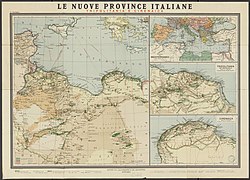
Libya is fourth in size among the countries of Africa and sixteenth among the countries of the world. It is on the Mediterranean between Egypt and Tunisia, with Niger and Chad to the south and Sudan to the southeast. Although the oil discoveries of the 1960s have brought immense wealth, at the time of its independence it was an extremely poor desert state whose only important physical asset appeared to be its strategic location at the midpoint of Africa's northern rim.

Benghazi is the second-most populous city in Libya as well as the largest city in Cyrenaica, with an estimated population of 807,250 in 2020. Located on the Gulf of Sidra in the Mediterranean, Benghazi is also a major seaport.

Omar al-Mukhṭār Muḥammad bin Farḥāṭ al-Manifī, called The Lion of the Desert, known among the colonial Italians as Matari of the Mnifa, was the leader of native resistance in Cyrenaica under the Senussids, against the Italian colonization of Libya. A teacher-turned-general, Omar was also a prominent figure of the Senussi movement, and he is considered the national hero of Libya and a symbol of resistance in the Arab and Islamic worlds. Beginning in 1911, he organised and, for nearly twenty years, led the Libyan resistance movement against the Italian colonial empire during the First and Second Italo-Senussi Wars. After many attempts, the Italian Armed Forces managed to capture Al-Mukhtar near Slonta and hanged him in 1931 after he refused to surrender.

The Italian colonizationof Libya began in 1911 and it lasted until 1943. The country, which was previously an Ottoman possession, was occupied by Italy in 1911 after the Italo-Turkish War, which resulted in the establishment of two colonies: Italian Tripolitania and Italian Cyrenaica. In 1934, the two colonies were merged into one colony which was named the colony of Italian Libya. In 1937, this colony was divided into four provinces, and in 1939, the coastal provinces became a part of metropolitan Italy. The colonization lasted until Libya's occupation by Allied forces in 1943, but it was not until the 1947 Paris Peace Treaty that Italy officially renounced all of its claims to Libya's territory.

Benina International Airport serves Benghazi, Libya. It is located in the borough of Benina, 19 kilometres (12 mi) east of Benghazi, from which it takes its name. The airport is operated by the Civil Aviation and Meteorology Bureau of Libya and is the second largest in the country after Tripoli International Airport. Benina International is also the secondary hub of both Buraq Air and flag carrier, Libyan Airlines. As of 17 July 2014 all flights to the airport were suspended due to fighting in the area.

Christianity is a minority religion in Libya. It has been present in Tripolitania and Cyrenaica since Roman times.

Libya was a colony of Fascist Italy located in North Africa, in what is now modern Libya, between 1934 and 1943. It was formed from the unification of the colonies of Italian Cyrenaica and Italian Tripolitania, which had been Italian possessions since 1911.

Italian Tripolitania was an Italian colony, located in present-day western Libya, that existed from 1911 to 1934. It was part of the territory conquered from the Ottoman Empire after the Italo-Turkish War in 1911. Italian Tripolitania included the western northern half of Libya, with Tripoli as its main city. In 1934, it was unified with Italian Cyrenaica in the colony of Italian Libya.

Italian Cyrenaica was an Italian colony, located in present-day eastern Libya, that existed from 1911 to 1934. It was part of the territory conquered from the Ottoman Empire during the Italo-Turkish War of 1911, alongside Italian Tripolitania.

Suluq is a town in the Benghazi District of the Cyrenaica region in northeastern Libya. It is located about 53 kilometers to the south-east of Benghazi.
Libya's second largest city, Benghazi, has a history which extends from when the city was first inhabited in the 6th century BCE to the present day. Throughout its history, the city has been continuously conquered by different ancient and colonial forces.

Libyan railways are the Italian colonial railways in Italian Libya. They are related to the development of the railways in the Italian colonial empire. This history started with the opening in 1888 of a short section of line in Italian Eritrea, and ended in 1947 with the loss of Italian Libya after the Allied offensive in North Africa and the destruction of the railways around Italian Tripoli. The railways in the Italian colonial empire reached 1,561 km before World War II.
Qaminis or Ghemines is a small town adjacent to the Gulf of Sidra in the Cyrenaica region of northwestern Libya. It is located about 50 km (31 mi) to the south of Benghazi, and 23 km (14 mi) west of Suluq.
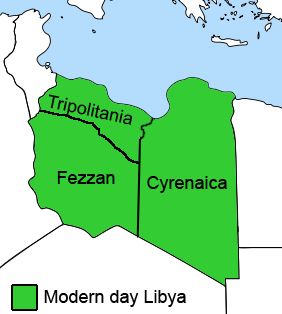
This is a survey of the postage stamps and postal history of Cyrenaica, now part of Libya.
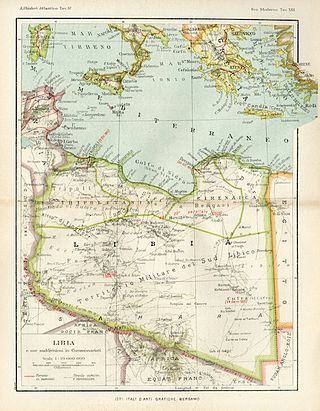
Benghazi Province, or Provincia di Bengasi in Italian, was one of the provinces of Libya under Italian rule. It was established in 1937.
The Port of Benghazi is a major seaport in the city of Benghazi, Libya, on the Mediterranean Sea coast within the Gulf of Sidra.
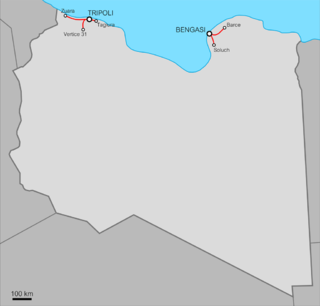
Italian Libya Railways was a group of small railways built in the Italian colony of Libya between the two World Wars.
The following is a timeline of the history of the city of Tripoli, Libya.
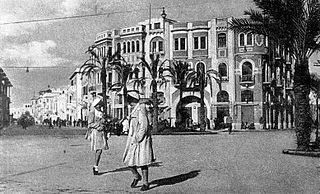
Italian Benghazi was the name used during the Italian colonization of Libya for the port-city of Benghazi in Italian Cyrenaica.

Berenice, was an ancient Greek and Roman era city near Benghazi in today's Libya, named after Berenice II of Egypt. The city was located on a raised piece of land in what is now the Eastern Benghazi suburb of Sebkha Es-Selmani.
